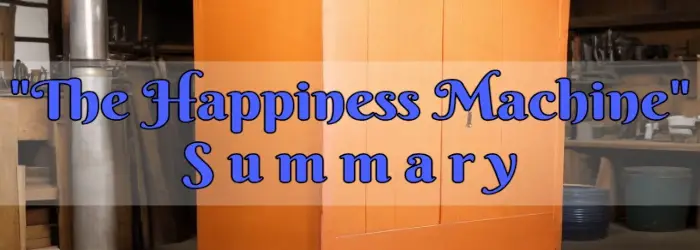
“The Happiness Machine” is a short story by Ray Bradbury that appeared in one form in the novel Dandelion Wine. This is a summary of the version of “The Happiness Machine” that appeared in the collection The Stories of Ray Bradbury. It’s about a man who puts great effort into building a machine to make people happy, but his wife doesn’t share his enthusiasm.
“The Happiness Machine” Summary
Leo Auffmann is in his garage on Sunday morning ready to start work on a Happiness Machine but he’s not sure how. He doesn’t know how big it should be, but he does know it should be orange. He takes a dictionary and goes to the kitchen where his wife, Lena, is slicing vegetables. He reads her the definition of “happiness” and asks if it applies to her.
She views the question as odd, believing happiness isn’t something you think about, you just live. While they talk, her bread burns and Leo leaves.
Leo works in his garage furiously and noisily for days. When feeling defeated, he’ll watch people who are in a good mood for hints on how his work should proceed. After ten straight days and nights of work, he stumbles into the house, fatigued and half-starved. The machine is finished.
Lena is concerned. Leo has lost fifteen pounds, she’s gained ten, and the kids are on edge. She thinks Leo will die if he keeps going like this. Leo passes out and falls to the floor.
Leo wakes up in bed upstairs the next morning. The Happiness Machine is on. He asked his son, Saul, to warm it up half an hour ago, but has forgotten. It’s drawing animals and people to it.
Lena brings up his breakfast. She questions the machines effectiveness—can it make old people young, if he dies will she be happy in it, and how does your whole life fit into the machine?
The machine continues to exert its attractive aura. Tomorrow, the whole family will try it together.
Leo is awakened during the night by the sound of Saul crying. He checks on his son, believing he had a nightmare, but Saul doesn’t answer.
The garage door is open. Leo goes out and finds the machine is hot from use. Saul was using it, but why was he unhappy? Leo sees the curtain blowing out from Saul’s room. It gives him a bad feeling, so he goes back in and locks the window. He sits with Saul.
In the morning, Lena is dividing their books. She doesn’t like that Saul is scared and they’re going.
“The Happiness Machine” Summary, Cont’d
Late in the day, Lena has finished diving all their things. Before leaving, she gives Leo a chance to prove his case. He leads her to the garage to the eight-foot-tall orange box. Saul warns her not to get in, but she needs to know. She gets in and Leo shuts the door.
Lena presses the button and the family listens. They hear Lena delighted as she experiences interesting places and sensations. To Leo’s surprise, she starts to cry. He opens the door. Lena explains the problem.
The places she saw and the things she did in the machine were wonderful, but they’re not real. When it stops, you have to return to regular life, and now you miss all the things you know you won’t get. It makes you think having certain things is important. It lies by telling you you’re young. The enjoyable moments in life aren’t meant to last a long time. We experience them and then want to move on to something else.
Leo wants to confirm the machine’s flaw himself. He gets in and starts it up. It catches fire and his family drags him out after he bangs his head trying to get up. Lena holds back Saul from calling the fire department until it blazes bright.
Many of the town’s people gather to watch the fire. Leo has to figure things out, but Lena says it won’t take long. He just needs to think. She’ll be inside putting the things back and preparing supper.
When the fire’s been put out, Leo stands with a neighbor family, the Spauldings. He knows now that what burned wasn’t the real Happiness Machine. They look in his front window and see his kids playing and his wife cooking. That’s the real Happiness Machine.
Leo goes inside. He contributes to the family’s activities, tinkering and making adjustments with the mysterious and ever-moving parts of daily life.
I hope this summary of “The Happiness Machine” by Ray Bradbury was helpful.